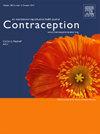利用美国社区调查和迈尔斯堕胎仪表板确定空间两极化与获得亲自堕胎护理之间的关系
IF 2.8
2区 医学
Q1 OBSTETRICS & GYNECOLOGY
引用次数: 0
摘要
方法 我们计算了县级的极端集中指数(ICE),该指数量化了不利条件和特权的极端程度,可作为结构性种族主义的替代指标。我们计算了在多布斯案之前(2022 年 3 月)和之后(2023 年 3 月)美国每个县的中心点到最近的堕胎诊所的距离。我们使用中位数检验比较了多布斯案前后的旅行时间。我们使用逻辑回归法来确定最近设施≥2 小时的 ICE 五分位预测因素,并对堕胎合法性和时间段进行了调整。中位旅行时间在多布斯事件后从 1.6(范围:0.1-6.7)小时增加到 2.0(范围:0-11.6)小时;p<0.001。在逻辑回归中,处于最弱势种族和收入 ICE 五分位数的人与处于最不弱势五分位数的人相比,在多布斯事件后,居住地距离人工流产机构≥2 小时的几率增加了(调整 OR (aOR) 2.32;95%CI:1.94-2.79),居住地距离人工流产机构≥2 小时的几率增加了(aOR 2.24;95%CI:2.01-2.51)。同样,处于最不利种族和收入五分位数的人与处于最不利五分位数的人相比,居住地距离人工流产机构≥2 小时的几率增加了 2.50;95%CI[2.09-3.01]),居住地距离人工流产机构≥2 小时的几率增加了 2.结论堕胎禁令增加了前往最近堕胎设施的旅行时间,这可能会增加已经面临系统性贫困和结构性种族主义的社区获得护理的障碍。本文章由计算机程序翻译,如有差异,请以英文原文为准。
USING THE AMERICAN COMMUNITY SURVEY AND THE MYERS ABORTION DASHBOARD TO DETERMINE THE RELATIONSHIP BETWEEN SPATIAL POLARIZATION AND ACCESS TO IN-PERSON ABORTION CARE
Objectives
We aimed to assess the relationship between spatial polarization and driving times from each US county to the closest abortion clinic before and after Dobbs v Jackson Women’s Health Organization.
Methods
We calculated county-level Index of Concentrations at the Extremes (ICE), which quantifies extremes of disadvantage and privilege and is used as a proxy for structural racism. We calculated the distance from the centroid of each US county to the closest abortion clinic before (March 2022) and after Dobbs (March 2023). We compared travel times before and after Dobbs using a medians test. We used logistic regression to determine ICE quintile predictors of the closest facility being ≥2-hours adjusted for legality of abortion and time period.
Results
We assessed 3,143 US counties. Median travel time increased from 1.6 (range:0.1-6.7) to 2.0 (range:0-11.6) hours post-Dobbs; p<0.001. In logistic regression, those in the most-disadvantaged race and income ICE quintile versus those in the least-disadvantaged quintile had increased odds of living in a county ≥2 hours from an abortion facility of (adjusted OR (aOR) 2.32; 95%CI:1.94–2.79) and the odds of living ≥2 hours from a facility increased by (aOR 2.24; 95%CI:2.01-2.51) post-Dobbs. Similarly, those in the most-disadvantaged ethnicity and income quintiles verses those in the least-disadvantaged quintile had increased odds of living ≥2 hours from an abortion facility of 2.50;95%CI[2.09–3.01]) and the odds of living ≥2 hours from a facility increased by 2.25;95%CI[2.01-2.52] post-Dobbs.
Conclusions
Abortion bans are increasing the travel time to the closest facility which may be increasing barriers to care among communities already facing systemic poverty and structural racism.
求助全文
通过发布文献求助,成功后即可免费获取论文全文。
去求助
来源期刊

Contraception
医学-妇产科学
CiteScore
4.70
自引率
17.20%
发文量
211
审稿时长
69 days
期刊介绍:
Contraception has an open access mirror journal Contraception: X, sharing the same aims and scope, editorial team, submission system and rigorous peer review.
The journal Contraception wishes to advance reproductive health through the rapid publication of the best and most interesting new scholarship regarding contraception and related fields such as abortion. The journal welcomes manuscripts from investigators working in the laboratory, clinical and social sciences, as well as public health and health professions education.
 求助内容:
求助内容: 应助结果提醒方式:
应助结果提醒方式:


